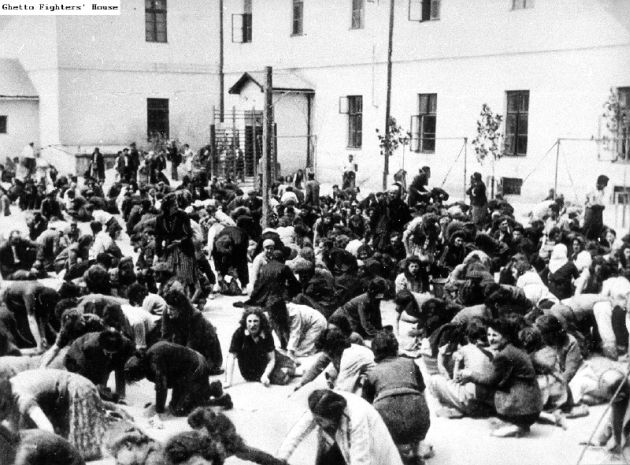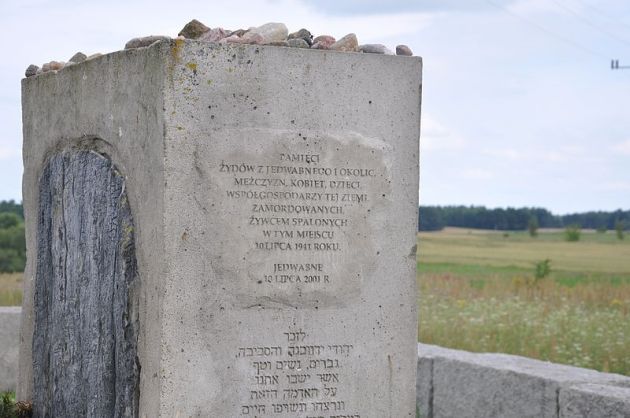26 June 1941: 2 in the morning, when it was already starting to dawn, I heard an engine. I approached the window. In front of a grey, wooden house opposite my apartment, at No. 13 Kant Street (whose caretaker was one of the first to raise the Nazi flag), a truck had pulled up. Several people got out of it. First they knocked the door open, entered and turned on the hallway light… Next I heard the loud, heart-rending cry of a woman, expressing indescribable horror… It lasted for a few minutes, and then a male voice sounded, he was shouting in the Jewish language, he was pleading, hurriedly repeating some garbled words, always the same… all at once gunshots (three or four), and suddenly all became quiet … A male voice, in Lithuanian said: ‘Don’t shoot until I say’, then came the plaintive cry of children, perhaps two children. Again two gunshots and silence… This means that they had shot four innocent people…
After a while, again I heard some stifled cries, followed by three pistol shots. Within an hour they shot seven or eight people—professionally, fast and methodically. The sound of the gunshots gradually became more and more distant… Now I know what they really mean! The truck engine throbs loudly, but the city is silent, the police do not appear. The Germans allow for such loud cries in the city they have captured, in whose streets no one is allowed to move freely. It is clear that the murderers are acting with the permission and approval of their new masters. … My first reaction was an urge to run out and cry for help. But to whom? Who would come? Who would help?! I write these words so that they may be preserved… I believe that there will be a trial, I believe that this will be avenged and that the murderers will be convicted! Truth will prevail, evil shall be punished…
27 June … Throughout the day the patriotic, sadistic intoxication persists: with the permission and approval of the authorities, Jews are being tormented and murdered… All Lithuanians, with only a few exceptions, unite in their feelings of hatred towards the Jews, and especially the intelligentsia, who under Soviet rule did not go with the flow; because of their nationalist stance, they did not actively collaborate but instead had held on to their position as the Jewish intelligentsia; apart from that they had suffered materially, since the state had taken over their houses and capital. Now revenge is being meted out for endured anguish and humiliation …
Through the day, people with the demeanours of victors and armbands with Lithuanian national colours throng the streets, break into houses, and in broad daylight take out Jewish property, not distaining to take even the most worthless items of junk. It is like an epidemic, and explosion of greed… They are all armed with rifles…
Everywhere you see the national colours, or white armbands with the red cross. The medical service is to collect the bodies of the murdered Russians and Jews. From the laboratory window I was able to see how those ‘sisters’ prepared for the trips: screeching, laughing, vulgar flirting, crude jokes… Only one of the nurses, a simple, uneducated woman, with sadness reported that those executed were Red Army soldiers, and the Jews were being herded to be shot, holding shovels with which they were first to dig their own graves and as they did so they were made to sing ‘If tomorrow brings war…’ [a Red Army song]
…The city looks desolate. …Reports come in of all conceivable humiliations to which the Jews are subjected, they are forced to take out manure with their bare hands. I saw a group of captured Jews being made to carry shovels. In the evening a female patient… told me she had seen in the cemetery how Jews who had dug their own graves were killed with wooden scantlings. …
29 June… A sunny, hot day… The patients told me the that the Jews are being forced to remove waste with their bare hands, dig pits with small shovels and drink from the drains; they must lie down in rows and are then savagely beaten over the head with iron rods or scantlings (this happened in a garage on Vytautas Prospect beyond the cemetery); the killed were thrown onto trucks and driven away somewhere to be buried. All these actions were carried out by the Lithuanians. The Germans did not participate, they only stood by and watched. Some of the Germans took photos. Simple, poor people, peasant, were horrified, they cried for the Jews and sympathised with them…



